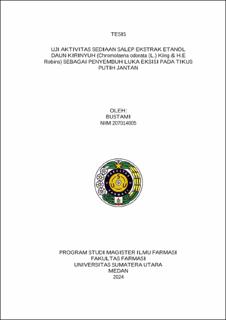Uji Aktivitas Sediaan Salep Ekstrak Etanol Daun Kirinyuh (Chromolaena odorata (L.) King & H.E Robins) sebagai Penyembuh Luka Eksisi pada Tikus Putih Jantan
Wound Healing Activity of Oinment Containing of Ethanol Extract of Kirinyuh Leaves (Chromolaena odorata (L.) King & H.E Robins) in Male White Rats Excision Wound Model

Date
2024Author
Bustami, Bustami
Advisor(s)
Hasibuan, Poppy Anjelisa Zaitun
Nasution, Martua Pandapotan
Metadata
Show full item recordAbstract
The kirinyuh plant (Chromolaena odorata) is one of the medicinal plants that is often used to stop bleeding, cure wounds and fever. Kirinyuh leaves contain secondary metabolites in the form of flavonoids that have anti-bacterial activity and saponins that stimulate the formation of fibroblasts and PDGF BB in wounds.
Antibacterial activity test was conducted using ethanol extract of kirinyuh leaves against Staphylococcus aureus, Pseudomonas aeruginosa and Staphylococcus epidermidis bacteria. The ethanol extract of kirinyuh leaves with the best antibacterial activity was formulated in the form of ointment preparations with concentration variations of 4%, 6% and 8%. Wound reduction test was conducted by calculating the percentage of wound reduction every three days. Examination of the number of fibroblasts was done by Hematoxylin Eosin staining method. While testing the expression of Platelet Derived Factor Growth (PDGF) BB using the IHC (Immunohistochemistry) method, by calculating the amount of skin PDGF BB expression on days 3, 7, and 14.
The results of antibacterial testing obtained the lowest concentration of ethanol extract of kirinyuh leaves that can inhibit Staphylococcus aureus bacteria at a concentration of 20 mg/ml (2%), a diameter of 10.60 mm, Staphylococcus epidermidis concentration of 20 mg/ml (2%), a diameter of 10.07 mm and Pseudomonas aeruginosa concentration of 30 mg/ml (3%), a diameter of 9.45 mm. The day 15 wound healing test showed the results, in the Betadine® group there was a wound reduction of 96.07%, control of 38.12%, SEEDK 4% of 80.93%, SEEDK 6% of 95.38% and SEEDK 8% of 95.75%. The SEEDK 6% and SEEDK 8% groups were not significantly different from the Betadine® group. The results of testing fibroblasts on day 7 obtained the average number of fibroblasts in the control group of 48.00 cells/field, the Betadine® group with the number of fibroblasts 70.60 cells/field and the SEEDK 6% group was 69.20 cells / field. The Betadine® group was significantly different from the control group, but not significantly different from the 6% SEEDK group.
The results of the PDGF BB expression test on day 14, namely the average PDGF BB score of the Betadine® group was 125.20 cells / field, while the control group had an average PDGF BB score of 106.40 cells / field and the average PDGF BB score of the 6% SEEDK group was 123.80 cells / field. The Betadine® group was significantly different from the control, but not significantly different from Betadine®. Based on the description above, it can be concluded that SEEDK has an effect on increasing excision wound closure, increasing the number of fibroblasts and the amount of PDGF BB expression.
Collections
- Magister Theses [371]
